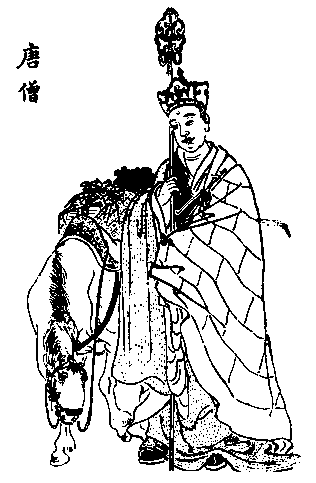 Hsüan-tsang and his dragon horse; from an edition of Hsi-yü-chi published in the 14th year of the Emperor Guangxu (1888). |
Buddhist monk and founder of the Buddhist Consciousness Only school in China, b. c. 602 (Ch'en-lu, China), d. 664.
Hsüan-tsang was born into a family of scholars and received the classical education based on the teachings of Confucius. An elder brother stimulated his interest in Buddhism, and he converted early in his life. China was in turmoil at the time, and in an effort to find a place conducive to religious study he and his brother travelled to Ch'ang-an and on to Ssu-ch'uan (today's Szechwan), where they devoted themselves to the study of Buddhist classics.
When Hsüan-tsang found contradictions in the Buddhist literature and was unable to get satisfactory explanations he decided to travel to the source of Buddhism in India. He left Ssu-ch'uan secretly without a travel permit in 629 and arrived in the holy land of Buddhism in the eastern Ganges region in 633. On his way he passed through the desert oasis centres of Turfan, Karashar, Kucha, Tashkent and Samarkand, continued through Bactria and the Hindu Kush into Kapisa, Gandhara and Kashmir and sailed down the Ganges river.
In India Hsüan-tsang visited all sacred sites and perfected his knowledge of Sanskrit in the famous Nalanda monastery, a centre of Buddhist learning. His reputation as a scholar became known at the court of king Harsa of northern India, and when the time came for Hsüan-tsang to return to China, king Harsa's protection made his travel much easier.
Hsüan-tsang left India in 643 and returned to Ch'ang-an in 645. A huge crowd had been awaiting his arrival, and the Emperor, after listening with awe to his accounts of the foreign lands, offered him a ministerial appointment. Hsüan-tsang respectfully declined, preferring to serve his religion.
He then set to work to translate the 657 Sanskrit texts that he had brought from India in 520 cases. He managed to translate only 73 of them, a total of 1,330 chapters. His translations contain some of the most important Mahayana writings.
Hsüan-tsang and his disciple K'uei-chi (632 - 682) established the Wei-shih (Consciousness Only school). It was based on Hsüan-tsang's work Ch'eng-wei-shih lun ("Treatise on the Establishment of the Doctrine of Consciousness Only"), a translation of Yogacara writings and a commentary by K'uei-chi. The school asserted that the world is only an image in the mind. Burdened with eccentric analysis of the mind and confusing terminology, it did not survive long after the death of its founders, but during its existence it was taken up by the Japanese monk Dosho, who adapted it to Japanese thought and established it as the most influential Buddhist school in Japan.
Hsüan-tsang's other important work, Ta-T'ang Hsi-yü-chi ("Records of the Western Regions of the Great T'ang Dynasty") is a detailed, accurate and extremely valuable description of all the countries through which he passed during his travels.
At Hsüan-tsang's death the Emperor cancelled all audiences for three days as a sign of public respect. Hsüan-tsang features as one of the main characters in the Chinese classic 16th century novel Hsi-yü-chi ("Journey to the West").
 Hsüan-tsang and his dragon horse; from an edition of Hsi-yü-chi published in the 14th year of the Emperor Guangxu (1888). |